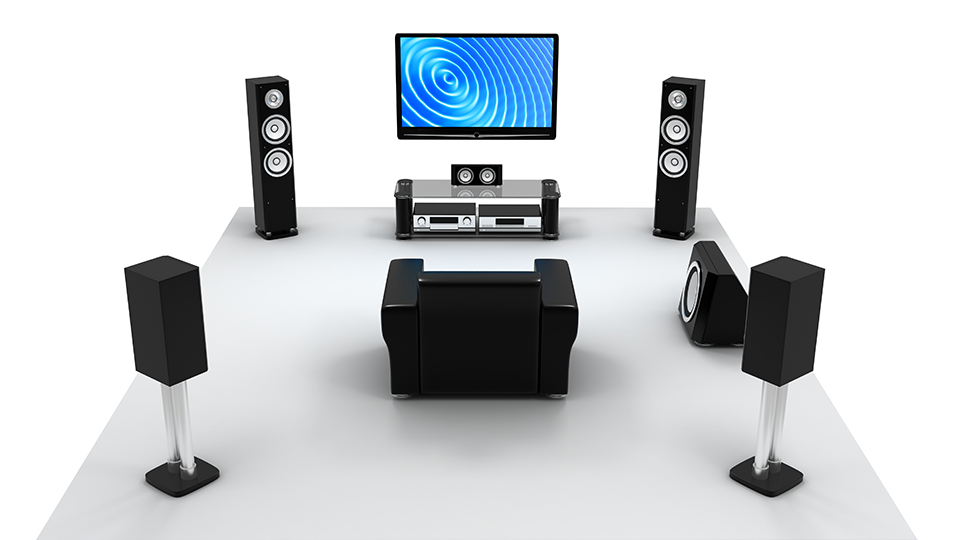Which Speaker Components Do What?
Speakers are a huge part of creating an immersive Home Theater experience. When everything is set up properly your speakers will work together with your display to create a truly immersive experience. There are a few basic different types of speaker systems, and set-ups. So how do you choose the proper one for your needs? First let’s identify some basic speaker terms.
Speaker types, terms and functions that you should know:
- Center channel – 90% of your dialogue and audio will come from this, this should be your best speaker
- Left/Right Front – Most of your sound effects, ambient sounds, some dialogue, and some bass will come from these. They are generally your largest pieces and have the most drivers
- Rear/Surround – These create the surround effect, and are generally the smallest pieces
- Bookshelf Speakers – Can be used for front or rear speakers
- Speaker Terminals – This is where you connect your speaker cable, they will be located on the back of your speakers, you simply match the light colored wire with the red terminal, and the dark with the black terminal
- Subwoofer – Your low end frequencies/bass will come from this. They vary in shape and size, most tend to be between 8”-12” in diameter
- Tweeter – Where the higher pitch sounds come from, they are generally 1” in diameter
- Woofer – Where your midrange sound will come from. They usually range from around 2.5”-8” in diameter
When everything is doing what it’s supposed to. The Tweeters, and Woofers work in unison to create one seamless sound.
Most popular Speaker System Setups:
- 5.1 surround sound – These systems consist of a center channel, left/right channel, 2 surround speakers, and a subwoofer. The subwoofer is the ‘.1’ at the end. So you have 5 speakers, plus 1 subwoofer which gives this popular set up the 5.1 name. This set up requires a receiver to power the speakers.
- 7.1 surround sound – These are a 5.1 system with 2 additional rear/surround speakers. This set up also requires a receiver to power the speakers.
- Sound Bars – are designed for people who want surround sound but either don’t want to run wires all over the place, or don’t have space for traditional speakers. They offer a simulated surround sound effect from one long speaker you would place under your TV. These systems generally come with a subwoofer and don’t require a receiver.
- HTIB – ‘Home Theater in a Box’ systems offer 5.1 or 7.1 set-ups without having to buy a separate receiver, and in some cases Blu-ray player. These systems are popular in the sub $1000 price range. They are often much cheaper than buying separate components, however they generally do not feature top of the line gear.
- Individual Speakers – You can also buy your speakers individually, picking and choosing exactly which ones you want and blending sounds as you see fit. Most speaker manufacturers release models by series. The speakers in a series are designed to match sonically, however this doesn’t mean you can’t mix and match with great success. This really isn’t the best option for Home Theater beginners.
Some things to take into consideration before you make your purchase:
- Budget – Speakers run from super cheap to thousands of dollars. There are solid buys in every price bracket. Find your budget first, and then start shopping. You can always upgrade later. I recommend starting a 3.1 system (2 fronts, center channel, and subwoofer) if you don’t have a lot of money to start out.
- Sound Preference – Unlike TVs, individual speaker preferences tend to vary wildly from person to person. Just because your friend likes his expensive new speakers does not mean you are going to like their sound too. Different cabinet materials create different types of sounds. You absolutely need to demo any speaker set you are going to buy.
- Use – What will you be using the speakers for primarily? If it is movies/TV then you will want to have a strong center channel and subwoofer. If it is for music, then you will want really strong left and right front speakers.
- Décor – Do you need your sound system to match your room’s décor? Can they be placed in the correct spot to achieve the maximum sound quality? There are speakers designed for all Home Theater situations from flat panel speakers, to in wall, to floor standing, to wall mountable.
Audio Tradeoffs
Audio purists will tell you that there is no way to get a full range of sound from small speakers like flat panel designs, or Bose type micro systems. You will get no argument from me here. It just isn’t possible for tiny speakers to produce the same sound stage of speakers with large woofers, and separate tweeters.
I have had some great sounding flat panel speakers, and some nice compact 5.1 speakers. They can really sound great, but when you put them up against some decent full sized towers or bookshelf speakers there just isn’t any comparison. There is nothing wrong with going with smaller speakers if that’s what you want to do. Just be aware of their claims to produce the same sound as larger speakers, as they are just not true.


